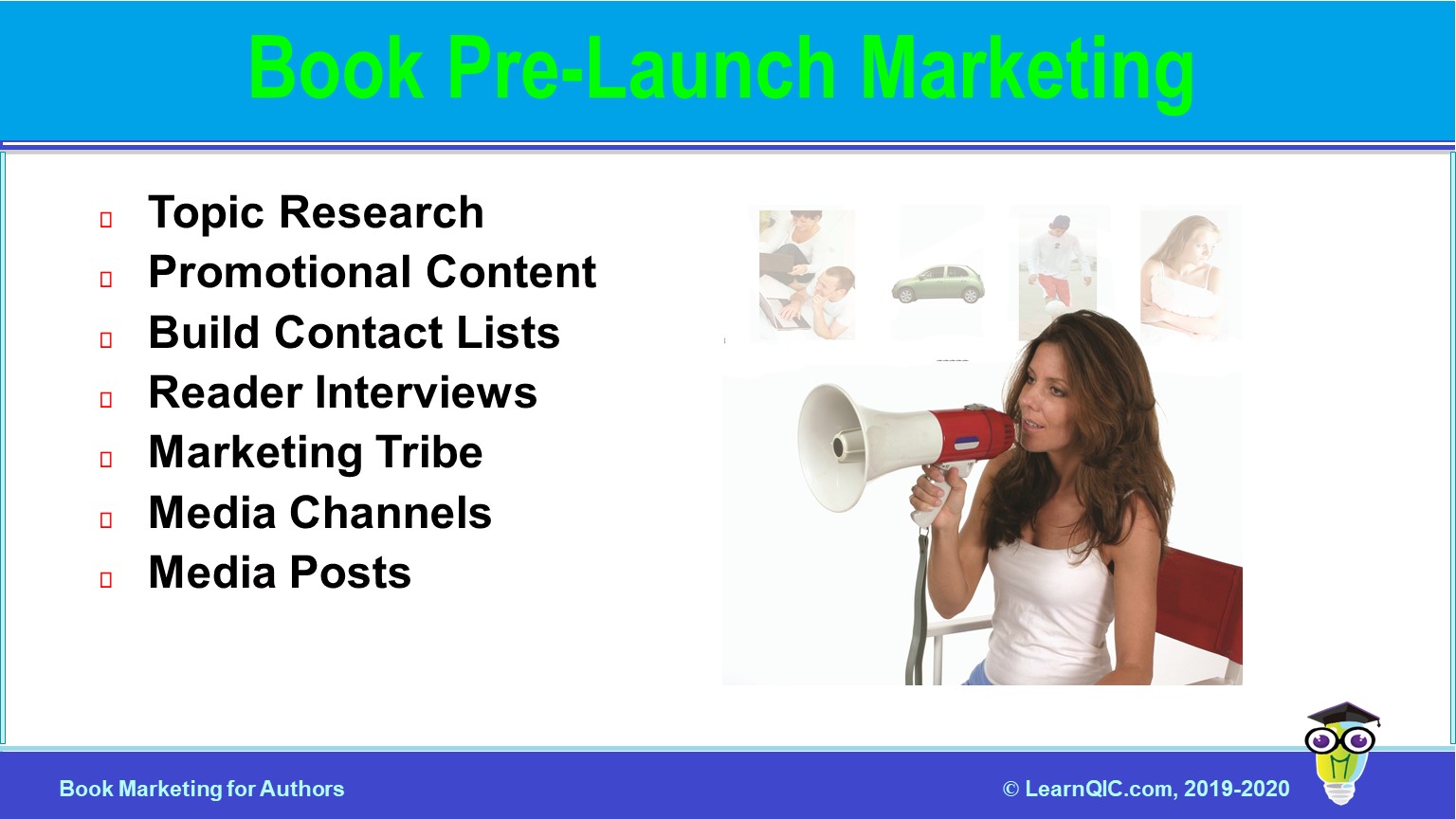
Book Pre-Launch Marketing
Book pre-launch marketing is media creation and publishing activities that authors, marketers, and publishers can do to promote and sell books that have not been published yet. In addition to helping authors and publishers to earn money before their book is released, book pre-launch marketing allows for gathering of feedback from future readers that can help make books better and discovery of information can be used for marketing activities.
Book pre-launch marketing is important because it takes time to setup and develop media channels, create marketing materials, and gather groups of people to help you to promote your book. Book pre-launch marketing enables authors to immediately begin to promote their book during its development. Doing book pre-launch activities can also help motivate you to complete your book.
The basic steps that I use for book pre-launch marketing include researching similar books, creating some promotional content, building a contact list, developing marketing tribes, setting up media channels, creating and publishing media posts.
Topic Research
Make a list and review 3 to 5 books that are similar to your book. This can be competing books or ones that appeal to the same types of readers. To find similar books, search for topics like your readers would search – your topic + “book”. You can search on Amazon.com or on search engines. You should also list and review 3 to 5 tutorials, articles, blogs, and other media items.
Review the descriptions of these books and media items to discover keywords and phrases, identify which channels contain information. Review the popular media posts (ones with likes, shares, and positive comments) and use them as a guide to make media post templates for you to use – Tweets, blog posts, discussion topics, and others.
Promotional Content
Create a searchable title, short summary, and draft cover image for your book. You can use a stock cover image, photo, or even get one created for a low cost on Fiverr.com. Your first attempts are likely to be not good. However, they will allow you to get feedback and suggestions.
Draft your book press release. This can include a ½ page description of your book and 5 to 10 key topics or solutions your book will provide. Your initial press release is likely to change as you develop your book. I put my initial book press release on my Google drive and share it with people who agree to do a book buyer journey interview with me.
Create a one page summary brochure for your book (also called a sales sheet). Your book brochure should contain a 1-3 paragraph summary, dominant buying motivators (DBMs), chapter or key topic list, key features, and book web page URL.
Create your book business card. Include your draft cover, title, and 3 key book buying motivators on the front. Include 10 to 15 key topic trigger words on the back. Your book business card will help you organize your thoughts when talking to people about your book.
Book Web Page
Register a web address (URL) to use for your book. It is ok to point (temporarily redirect) this URL to your book Facebook page or blog until you can get a website or web page setup. Include your book description and basic details on your book web page.
It is ok (recommended) to create a book product page on a blog such as a WordPress.com page. You will use this web address to pre-promote your book. It does not have to be pretty or perfect. It needs to include basic information about your book such as the title, cover, and description. You can include your book prices (print, ebook, etc), ISBN, size, and other details as you get them.
Book Blog
Setup a book blog where you can share information about your book and related media. You can start by using a free WordPress.com account. You can convert your free WordPress.com site to a regular website later which will allow you to add features such as book purchase and payment options.
Build Contact Lists
There are several groups of people that are involved in the development, promotion, and distribution of your book. Start by creating simple lists of your book development team (editor, illustrator, etc), reviewers, influencers, and others. I create Google spreadsheets for my initial contact lists. Spreadsheets can be easily expanded with categories, details, and communication history.
Contact 20+ influencers and companies to request photos, tips for your book. While these materials will make your book better and more interesting, you can include a list of these contributors and their company names in the acknowledgement section in the front of your book. Send these people copies and ask for them to post book reviews on Amazon and other places that sell your books. These people will become some of the best promoters for your book!
You should also setup a master email list so you will be able to organize and send messages to groups of contacts. I use Mailchimp which is free for several thousand contacts. Setting up a master email list during book development will help you to learn how to manage your contacts and send broadcast emails before you launch your book. Being able to send announcements about your book is critical to developing and growing relationships with your book buyers, readers, and influencers.
Reader Interviews
Talk with 10 to 20 qualified book readers and reviewers to get feedback that helps to make your book along with learning media sources that your readers trust and use when buying books like yours.
I’ve seen that some authors who are shy or afraid of promoting their book get excited about finding and talking with potential book readers about their book. Pre-launch book marketing can be highly inspiring and motivational.
Reader interviews typically take 30 to 90 minutes. While phone interviews are good, I prefer to buy my local interviewees lunch as a restaurant of their choice. This puts them at ease and because it is lunch, it tends to cost about $10 max.
Interviews should start by asking the person to share their background, interest in your book topic, and key things they would like to see in a book like yours. It is important to get their perspective and topics before sharing your book info with them to avoid bias. Create a book key topic list and ask your interviewee to rate their interest or need for each of the topics – typically 1 is very low interest and 10 is highest interest. After talking with 10 to 20 people, you should be able to determine from your topic ratings list which top 3 topics are most important to all your readers. These top 3 are your dominant buying motivators (DBMs).
Marketing Tribes
Setup your marketing tribe (also called a street team.) Find, connect with, make a list of 10 to 20 people you can request to love, comment, and share your media posts.
Create a ready to customize and publish sample media posts. Organize them into types of posts (technical, business, etc) so you can find some that match your marketing tribe members profile type.
Send media post requests messages. Send up to 3 request messages with simple instructions on what and where to publish. Include a sample message or words you would like them to share or publish. Create templates of request and messages to save you time in communicating – put these sample messages in a temp (scratch file).
Setup and use a media post tracking spreadsheet to identify the requests you send, date you sent first request, 2nd request, and final request, URL of the published post, and date it was published.
Media Channels
Create or join 10 to 20 media channels that you can use to promote your book (Twitter, Pinterest, Discussion Group, Facebook Page, Linkedin Page, Youtube, etc). Create a list for your media channels, include the URL, purpose (topics, message scope), and how often you plan to post on the media channel (daily, 2-3x per week, monthly, etc).
Media Posts
Create a text file for each media channel (e.g. Tweets, Blog Posts, Pinterest Images, etc). Put a heading for each post (heading 2). Add a date next to the media post when you publish it (easy tracking.) Gradually write media posts you plan to publish.
Search like your readers would search and find sample media posts. Use them as examples to create your media posts. Do not copy and reuse other media posts. In addition to violating copyright, search engines can penalize or not value duplicate content.
Create media posts – NO EXCUSES – if you don’t know what to publish, search like your readers and find more examples.
I put RRR next to the heading of a media post that is ready to be published. When I’m ready to published (use the media channel list post publishing periods) – I search for RRR, copy and publish that media post, change the RRR to the date I published, and insert the link below the
